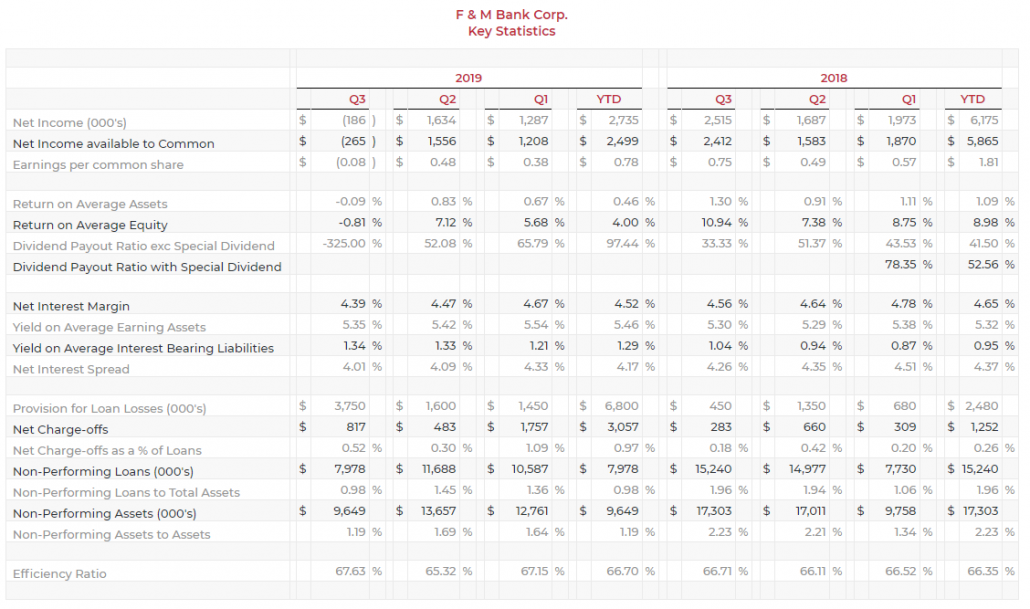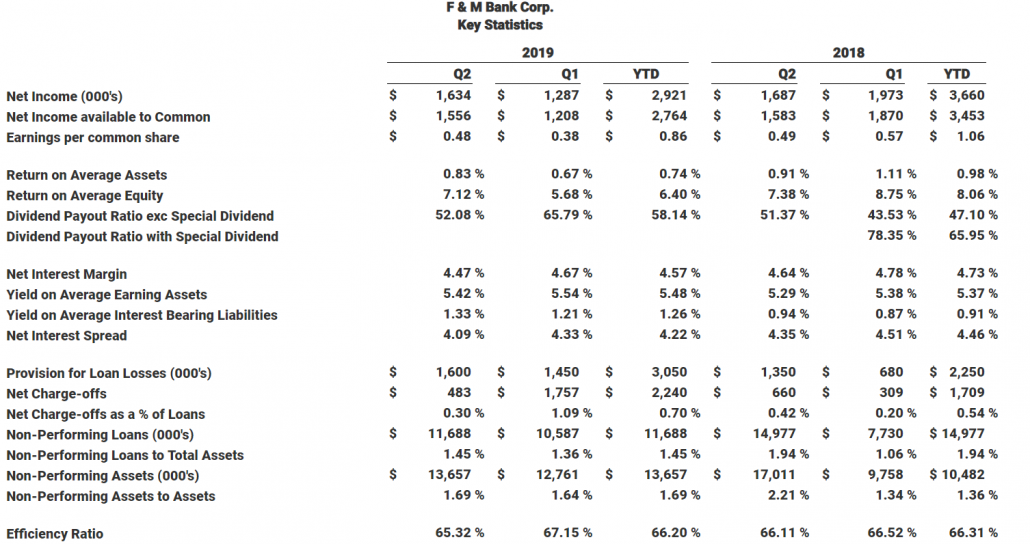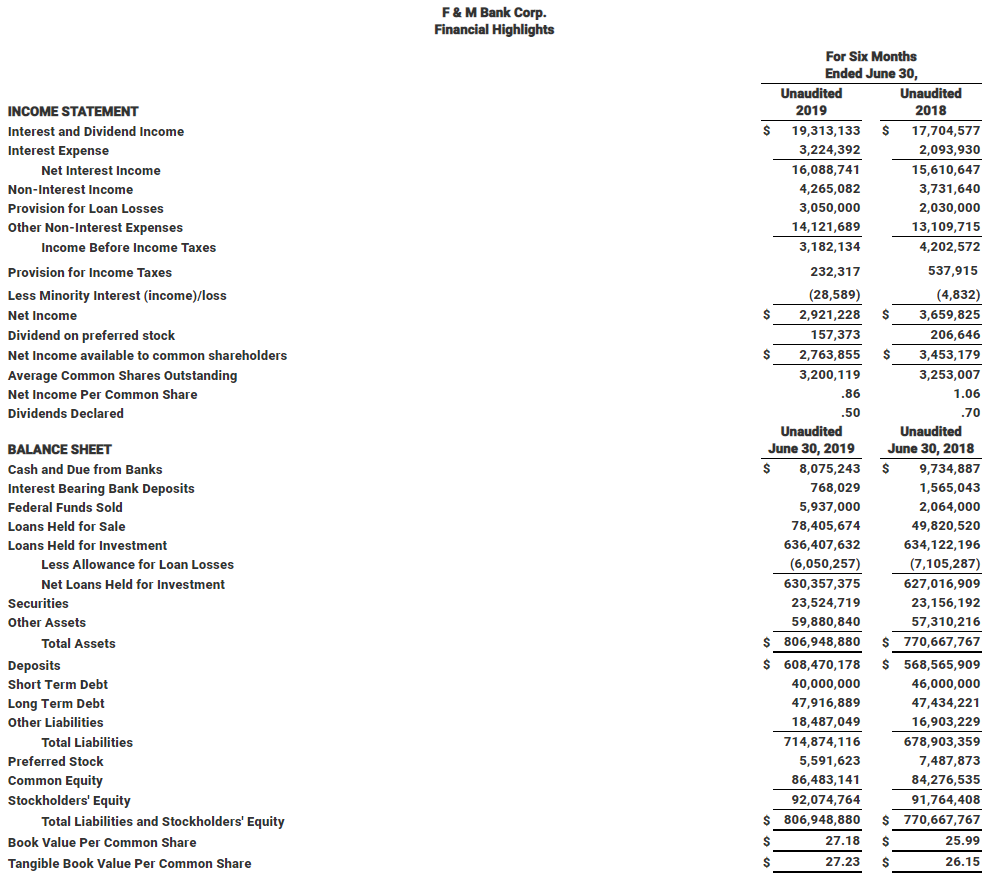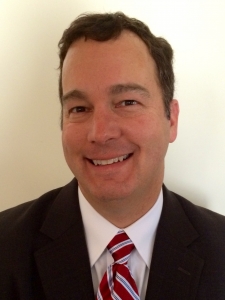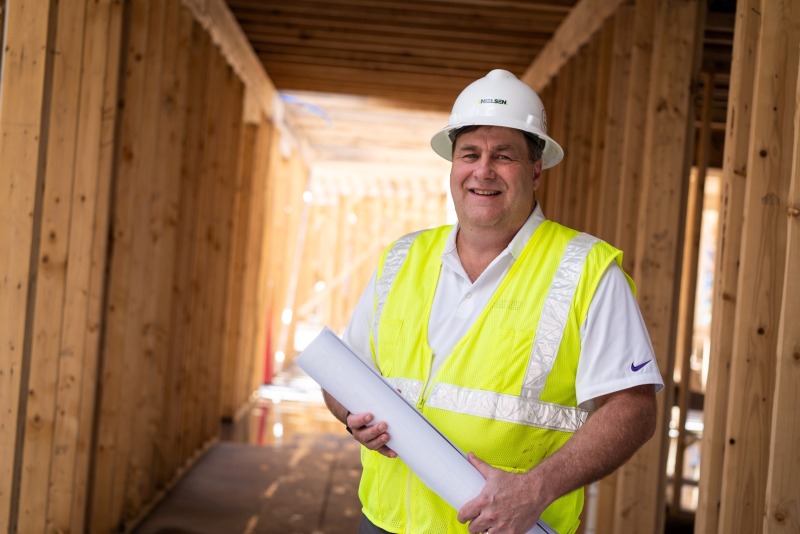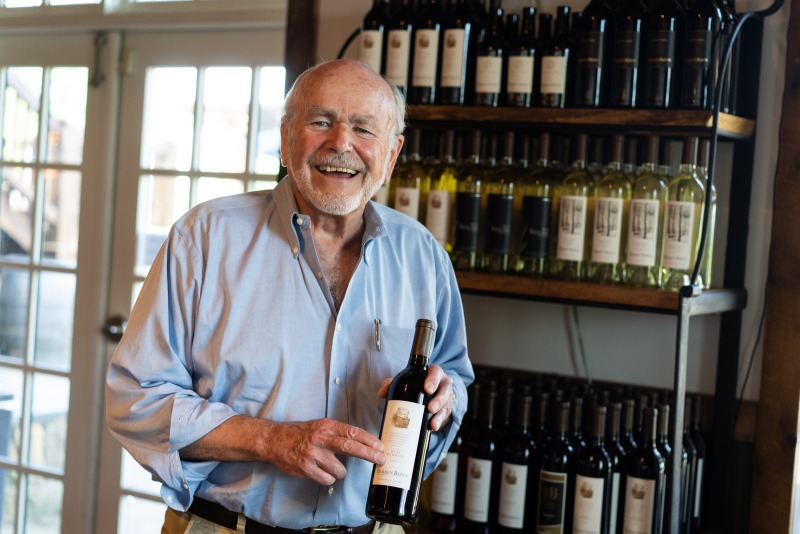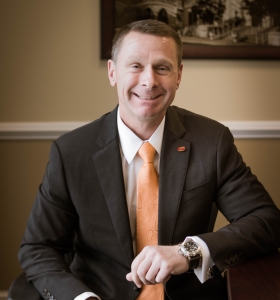
An interview with Mark Hanna, President and CEO of F & M Bank Corp
(OTCQX: FMBM)
Interview conducted by:
Bud Wayne, Editorial Executive, CEOCFO Magazine
Published – December 9, 2019
Re-published with permission
CEOCFO: Mr. Hanna, would you tell us about your role at F & M Bank Corp. and how it developed to where you are today as President and CEO?
Mr. Hanna: I joined the bank roughly two years ago on December 1st, 2017. The former CEO Dean Withers had announced his retirement and a search for his replacement was underway. At the time, I was in banking in the Hampton Roads area of Virginia. I had long worked with big banks and served as President and CEO of a de novo community bank, founded in 2005, that sold to another bank in 2014. After a period of working for the bank that had acquired my former company, I decided it was time for me to pursue some personal and career goals.
I knew Dean through a couple of banking organizations, so I reached out to him and expressed my interest in the opportunity. The board brought me in to interview along with several other candidates, and ultimately offered me the job. Dean stayed onboard for the first six months to help me through the transition. We had, and still do have, a close working relationship as he remains on F&M Bank’s board and is currently serving as our vice chair. Since then, the Leadership team and I have been working hard to guide and direct an organization that has 111 years of history for continued success in a dynamic banking environment.
CEOCFO: Would you give us a little background and history of the bank and how it developed from its founding? Has the vision changed much from its founding vision?
Mr. Hanna: We go by F&M now; it originally started as Farmers & Merchants in 1908 in Timberville, Virginia in the Shenandoah Valley, to serve farmers and merchants in the immediate area. Where I sit today is less than a mile away from our original headquarters. We are in Rockingham County, Virginia which is the largest agricultural county in the commonwealth of Virginia. There is still a strong agricultural base in this area, but the community has grown and evolved over the years. Harrisonburg, one of the faster growing communities in the commonwealth, is less than fifteen miles away from Timberville. Harrisonburg is home to James Madison University, which has an undergraduate enrolment of almost 25,000 students and is one of the stronger economic centers of our community and in the Commonwealth of Virginia.
CEOCFO: Has the vision changed much from its founding vision?
Mr. Hanna: Yes, it has evolved but also remains very much the same. We are still here to serve the needs of the community and we bank small to midsized businesses that include agriculture, manufacturing, distribution, commercial real estate development, and residential real estate development and more. We also provide personal banking products for individuals, ranging from deposit accounts to home equity lines to any credit needs they may have. Over time we have developed an indirect dealer division for auto loans and a mortgage company –– F&M Mortgage – for consumer mortgage loans. The bank itself has a strong portfolio of customized personal mortgage loans. It is a very popular product around here given that there are a lot of non-conforming properties such as larger tracts of land or family farms. We aim to provide the deposit, investment and loan products and services consumers in the Shenandoah Valley need.
CEOCFO: Are you more of a business/commercial bank than a consumer bank? What is the mix and would you like to see that change?
Mr. Hanna: I think it is split about 50/50. We do a lot of both. We have a full menu of personal services. We have a strong loan portfolio of what we call “shelf mortgage loans” which are non-conforming mortgages and we also offer a variety of conforming mortgage products through F&M Mortgage. We also provide a variety of services to many different for-profit and not-for-profit entities. F&M has historically provided significant financial and volunteer support for charitable organizations in our communities and this year we launched a new, comprehensive suite of banking services – which even includes training for their employees and directors – to support these organizations with their financial needs.
CEOCFO: How big a part is mortgage lending for you and is it in the commercial or consumer side of the business?
Mr. Hanna: We serve both the commercial and consumer sides of mortgage lending. With the small to midsize commercial focus that we have, we do a lot of commercial mortgages, those are all portfolio and we service all our loans in-house. We have the separate division, F&M Mortgage, that is very active in the consumer market with conforming loans which traditionally offer the lowest rates and longest terms.
CEOCFO: What role does wealth management play in your strategy? Is this more for customer relations?
Mr. Hanna: We have a phenomenal investment division with very knowledgeable and high-performing financial advisors. We strive to serve the full spectrum of our clients’ financial needs, so we are happy to leverage the trust that we create with their banking relationship to help them with their short-term and long-term investment needs. Being around since 1908 in our communities, clients trust that we will continue to serve their best interests today and for future generations.
CEOCFO: What are some of the things you are doing in the area of customer satisfaction and customer retention?
Mr. Hanna: As a community bank we are about $815 million in assets. Client service is everything and if we fail to provide superior client service, we commoditize ourselves. We survey customers during the onboarding process to determine what they thought of our process, the people that they dealt with, and the products that they were offered. We also host community and client focus groups to help us identify opportunities and consumer needs. Throughout the year we do a lot of things to remain engaged with our clients. We host a variety of client appreciation events that include free document shredding days and special events geared towards kids such as free photos with Santa around the holidays. We also partner with local universities. In 2018 we had the largest tailgate in the history of James Madison University football. Once we learned of this, we had to go out this year and beat our own record. It will be tough, but we will try to keep setting the goal higher in 2020. James Madison has had a very successful football team so those client appreciation events have been extremely well attended and are a great way for our clients to network with leaders in our community.
One of the things that we take very seriously is giving back to our communities. We are a very benevolent organization that gives back and supports many causes. Sometimes we work through our clients to support charities that are important to them, which contributes to our service and retention. We have a symbiotic relationship with the Shenandoah Valley. As these communities prosper, the bank tends to flourish. Likewise, if the bank is growing and strong, we re-circulate everything from deposits, to dividends, to shareholder wealth back into the communities. That certainly has a multiplier effect which serves to grow our local economies.
CEOCFO: The world seems to be taken over by the millennial generation and now the generation Xers, who are more into technology. Do you offer the technology and FinTech products that they are looking for?
Mr. Hanna: Yes, and that is a challenge, but we do. The budget to be at the cutting-edge of new technology is overwhelming. We are probably what I would classify as a technology follower. We work with multiple vendors to provide all the bells and whistles, but we try not to make the large R&D bets in developing new technologies. We like to determine what technologies our clients want and invest heavily in those areas.
Getting back to the millennial generation, one of the things that we embrace is social media to promote the bank, to interact with our clients, and to interface with our communities. We are very active there. As you look at millennials –– and this does not necessarily relate to technology –– but one of the things that we recognize is that millennials tend to look for organizations with strong values that are active in their communities, making their communities better. These are attributes that F&M has embraced for 111 years and have really helped us connect with millennials and generation Xers at the local level.
CEOCFO: Would you tell us about the communities that you serve in Virginia. Are they more rural or urban? What are some of the businesses in the area and the employment availability for residents? Do they depend more on D.C. for employment or local businesses? And do they support their local banks?
Mr. Hanna: We are not far from the D.C. suburbs, but I would not say that our economy is heavily driven by D.C. There are folks that commute to the D.C. area but most of our economy is locally based. Two of the counties we serve, Rockingham County and Augusta County are number 1 and 2, respectively, in Virginia in terms of agricultural production in the state. Agriculture drives a significant amount of ancillary businesses that includes businesses such as veterinary services, feed, storage, processing, equipment sales and service, livestock auctioning, transportation and more.
We have a few small urban cities such as Harrisonburg and Staunton in our footprint that are fairly well diversified in terms of industries represented. Neither are large cities but they are both vibrant and growing. Harrisonburg has been impacted by James Madison University, which has been one of the fastest-growing universities in the state and in the Southeast. The University has grown to almost 25 thousand undergraduates. As it has grown, the amount of new infrastructure on and around the campus has certainly been a large contributor to our local economy. Staunton is also a city with a strong economy, a business-friendly environment, and affordable tax rates. Several well-known companies like Hershey and ComSonics have relocated or expanded there. We are fortunate to have several other Fortune 500 businesses like Molson Coors and WalMart Distribution in our footprint as well. We find that other locally based companies often support local banks like us due to our knowledge of the local markets, the flexibility we can provide and our focus on service and relationships.
CEOCFO: How many branches do you have and are you looking to grow that number in the near future?
Mr. Hanna: We currently have 14 retail bank branches, three F&M Mortgage offices, three VS Title offices and our Dealer Division offices. Timing is everything, so as we sit here today, we look to be opportunistic in our growth. We recently added our fourteenth branch in August of this year. That was the last of five branches added to our footprint through de novo expansion. De novo growth occurs when we open a new banking office with zero assets and try to grow the business from the ground up. We opened five new branches reaching into the southern part of our footprint, primarily in the Augusta County market, between June of 2015 and August of 2019.
We have been aggressive in trying to grow our infrastructure but as of today, we are more in an absorption role as we aim to aggressively leverage those investments and get the returns that we were looking for. Should an opportunity present itself, there are other segments of our community where we would like to expand with either physical retail facilities or through a loan production office. Although we are not actively seeking new investments at this time, we will continue to keep our ear to the ground.
CEOCFO: What is your management style? Are you more hands on or depending on your officers?
Mr. Hanna: I like to be out working with our team and meeting with our clients. I enjoy getting to know both our clients and our associates. We have a great staff here at the bank and I delegate to the folks who are well equipped to handle different situations. The way banking is today, I don’t honestly believe anyone can be an expert in all the different functional areas we have to oversee. On a daily basis, F&M has to manage existing and emerging technologies, regulatory compliance, loan underwriting, portfolio diversification, liquidity, asset and liability pricing just to name a few. All this needs to be done behind the scenes so that we can focus our client-facing teammates on maintaining dynamic sales and client retention efforts. One person cannot keep up with it all, so I rely heavily on F&M’s Leadership Team as well as our Board of Directors.
CEOCFO: Do you have a Chief Security Officer?
Mr. Hanna: We do! We have an information technology department and an information security officer that is independent from IT who identifies risks and establishes protocol to keep our Bank and client information secure. It takes a lot when you consider all the potential threats coming at us like Ransomware, malware, phishing attacks and so on. In addition to technology, we have to actively manage risks that may be presented to us through our vendors and facilities. Bank security is a huge and growing area.
CEOCFO: What do you look for in your tellers, bankers, lenders and support staff?
Mr. Hanna: We are a relationship business. We have to provide outstanding, unrivaled customer service and a lot of that is cultivating relationships, knowing our clients, serving their needs and being there for them in good times and bad. A lot of what we look for are people who have a passion for serving the needs of their clients as well as their communities. Outside of that there is a growing list of technical skills and knowledge required to run a bank in 2019. It used to be that we could train our associates in the skills it took to run a Bank but more and more we have to recruit specific technical skills.
CEOCFO: How did your bank manage to survive the TARP period?
Mr. Hanna: We have been a strong and high-performing financial institution for many years. While the opportunity was available, the bank was well capitalized and chose not to take preferred shares through the TARP program. We had a capital base to draw from and continued to run a strong, well-capitalized bank during those difficult years. Like every organization that I know of, we encountered our share of challenges, but overall, F&M came through that period stronger than most.
CEOCFO: What is your current funding position? Is reaching out to investors an important role for you as CEO?
Mr. Hanna: We are very well-capitalized, so we are not actively trying to attract new capital. That said, we do reach out to current and new investors to create interest in F&M, to communicate our performance, and to create transparency around any challenges or opportunities we face. Over the years, F&M stock has done well. Currently, we are not enamored with our stock performance but we have undertaken some changes to better position our organization for the future. My belief has been if you are transparent with your investors and they understand your challenges and opportunities, hopefully they will remain patient and buy-in to the path forward.
CEOCFO: In closing, what sets F & M Bank apart from other local banks and why are you important to the fabric of the community?
Mr. Hanna: I think this includes a lot of what we have talked about. F&M Bank is the only publicly owned company still headquartered in Harrisonburg and Rockingham County, Virginia. We take that seriously and I think the community embraces that. Our clients and community members understand the long, rich partnership that F&M Bank has had with the Shenandoah Valley and the communities we serve. F&M has maintained a positive reputation since 1908 serving the needs of our clients and the community. We have been an integral contributor to the growth of the Shenandoah Valley and we hope to be involved in the continued development of these communities for another 111 years to come.
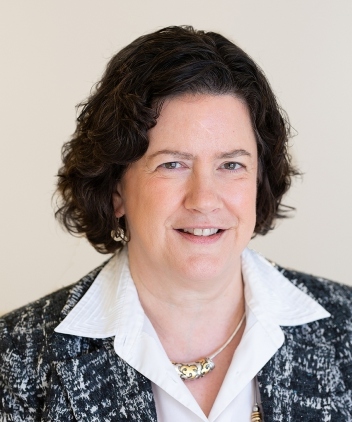
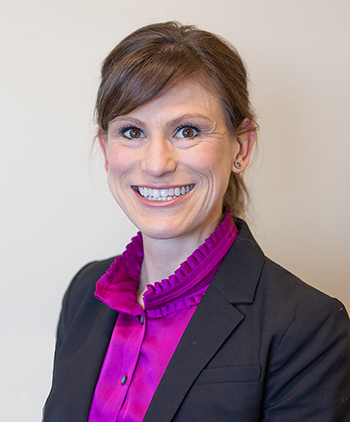

 F&M Bank is pleased to announce the promotion of Mary Pavlovskaya to Business Deposit Services Officer. Since 2011, Mary has served in a variety of roles at F&M Bank: retail, back office, and compliance. Her well-rounded experience in the banking industry is an asset as she transitions to a commercial role.
F&M Bank is pleased to announce the promotion of Mary Pavlovskaya to Business Deposit Services Officer. Since 2011, Mary has served in a variety of roles at F&M Bank: retail, back office, and compliance. Her well-rounded experience in the banking industry is an asset as she transitions to a commercial role. F&M Bank is happy to welcome Matt Hill as Commercial Relationship Manager to the Augusta County Business Development team. Matt brings with him over 13 years of lending and credit experience including consumer, mortgage, agriculture and commercial.
F&M Bank is happy to welcome Matt Hill as Commercial Relationship Manager to the Augusta County Business Development team. Matt brings with him over 13 years of lending and credit experience including consumer, mortgage, agriculture and commercial.